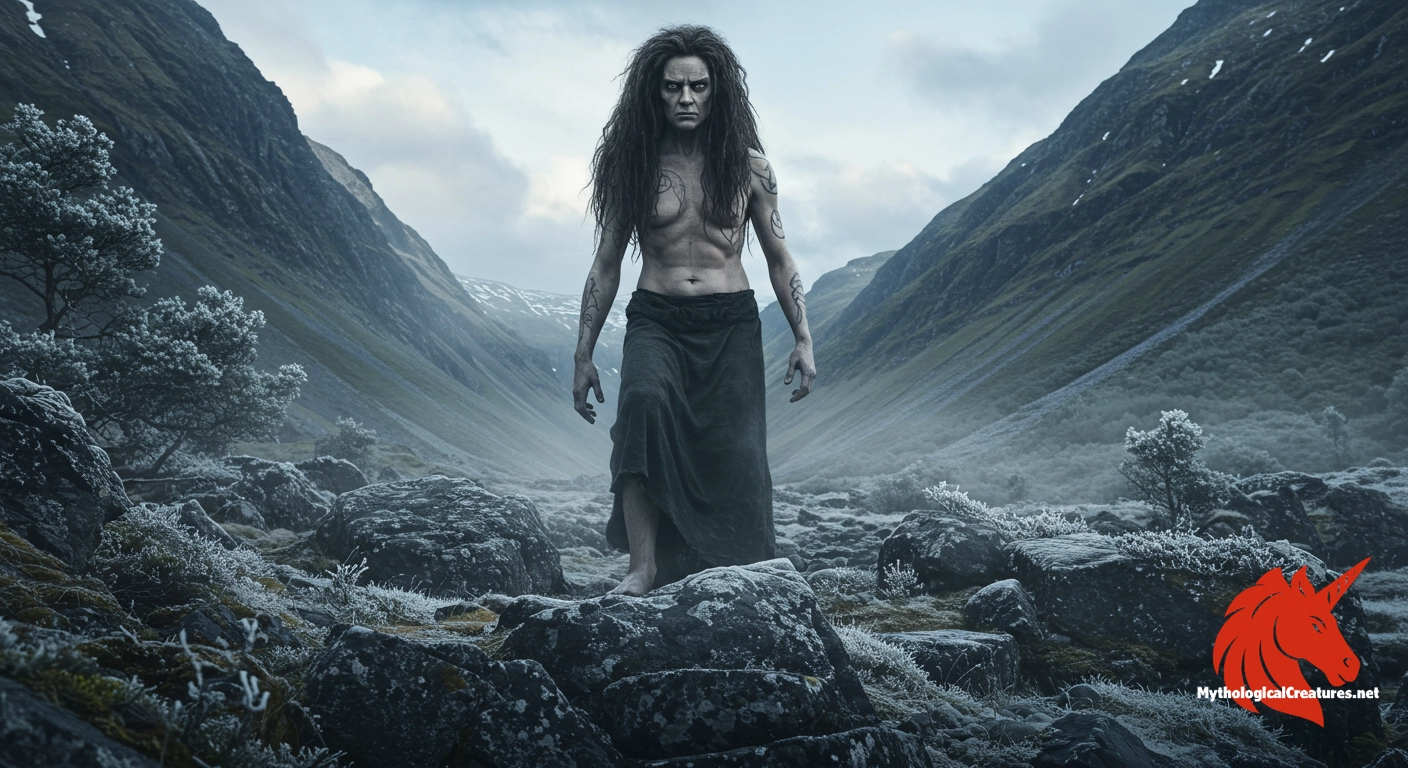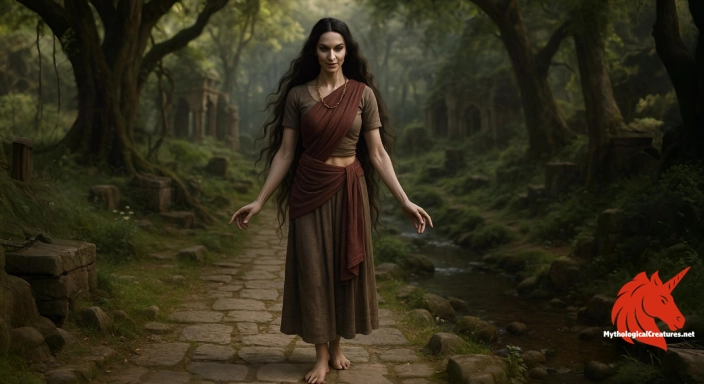Angrboða: Angrboða is a jötunn and giantess from Norse mythology, renowned as the mate of Loki and the mother of the monstrous Fenrir, Jörmungandr, and Hel.

Angrboða
Angrboða - Angrboða is a critical figure in Norse mythology as the progenitor of Fenrir, Jörmungandr, and Hel, whose fates are intertwined with the cosmic events of Ragnarok.
Origins & First Encounters
Angrboða emerges from the murky depths of Norse myth as a formidable giantess whose legacy is as dark as it is enigmatic. Born in an age when the boundaries between gods and giants were fluid, her story is interwoven with themes of chaos, transformation, and the inevitable confrontation between order and dissolution. Her name, resonant with ancient power, hints at sorrow and strife, encapsulating the dual nature of creation and destruction that defines much of Norse lore. She is most famously known as the consort of Loki, a relationship that has set the stage for a narrative where seduction and catastrophe coexist. Her myth, although sparsely recorded in the early sources, carries a weight that has fascinated storytellers and mythologists for centuries. The interplay of her identity with that of her infamous partner infuses her character with a complexity rarely seen in mythic genealogies. This intrinsic ambivalence makes her a figure of both reverence and dread in the Norse cultural landscape. The austere references in the sagas only hint at a deeper, perhaps darker, personal history that has since been expanded by later traditions. Her enduring presence in the corpus of Norse myth underscores a timeless intrigue, continually inviting reinterpretations and fresh insights.
The enigmatic aura that surrounds her has cemented her position as an essential, if elusive, character in the tapestry of ancient Scandinavian narratives.
Source Texts & Tale Variants
The narrative threads of Angrboða are woven through a delicate fabric of ancient texts and oral traditions that have survived from a time when myth and history were indistinguishable. Although her appearance in the Poetic Edda, specifically in Völuspá hin skamma, is brief, it sets a precedent for her role as the mother of creatures that defy conventional order. The Prose Edda, particularly in the section known as Gylfaginning, expands upon her character by detailing her connection with Loki and naming her monstrous offspring—Fenrir, Jörmungandr, and Hel. Each textual reference, however succinct, lays the groundwork for an expansive myth where familial ties directly influence cosmic balances. The scarcity of early mentions has not deterred later storytellers, who have found ample space to embellish her persona through both written and oral retellings. Variations in her narrative have appeared in different saga traditions, sometimes adding layers of tragedy or empowerment to her character. Some regional accounts, passed down through centuries, hint at episodes of ritualistic significance that centre around her mysterious origins. These multiple strands of legacy, while divergent in detail, collectively contribute to a mosaic of stories that frame her as both a cautionary and a transformative figure. This plurality of sources continues to inspire debate and creative reinterpretation in modern depictions of Norse myth.
Minor discrepancies among texts have only enriched her legend, making her a perennial subject of scholarly and artistic exploration.
Form & Powers
Angrboða’s physical embodiment is as imposing as it is enigmatic, reflecting the untamed essence of the jötnar to which she belongs. Her stature is depicted as monumental, a testament to the raw, almost elemental power that giants were believed to possess in the ancient world. Artistic visions of her often showcase an arresting blend of beauty and ferocity, with features that are both alluring and starkly otherworldly. Dark, penetrating eyes, which seem capable of reflecting the abyss of primordial chaos, are a common motif in interpretations of her visage. The wild cascade of her hair, frequently depicted in inky, unrestrained locks, further accentuates her connection to the elemental forces of nature. Her skin, rendered in earthy hues reminiscent of the rugged landscapes of Jötunheimar, evokes images of ancient stones and weathered cliffs. Nuanced details, such as subtle, almost mystical markings or adornments, sometimes appear in later artistic renditions, suggesting ties to forgotten rituals or natural cycles. The inherent contrast in her appearance—between beauty and terror, allure and menace—serves to embody the ambivalent nature of her myth. Despite the lack of exhaustive canonical description, contemporary visual interpretations have continually sought to capture her as a living symbol of the raw, untamable forces of the natural world.
Modern artistic revisions further explore these visual elements, blending classical iconography with innovative, symbolic embellishments that honour her legendary status.
Regional Faces
Across the diverse cultural landscapes of the Norse world, Angrboða’s character has been refracted through local traditions and communal imaginations. In Icelandic sagas, for instance, her portrayal is imbued with an air of profound isolation and enigmatic sorrow, reflecting the stark and rugged highlands of the region. Scandinavian folklore has, at times, merged her identity with that of other giantesses, thereby expanding her mythos to include themes of elemental power and the wild unknown. In these local narratives, every nuance of her character is adapted to harmonise with the natural and spiritual ethos of the community, often depicting her as both a harbinger of calamity and a keeper of ancient, arcane wisdom. Regional variations also lend her a more personal, humanised aspect, sometimes emphasising a tragic solitude that underscores the darker motifs of her lineage. The fluidity with which her myth is expressed allows different communities to project their own values and fears onto her figure. This adaptability means that while the core attributes as a progenitor of fearsome monsters remain constant, peripheral details may vary considerably from one locale to another. Such divergent interpretations reveal a rich tapestry of narrative evolution where local customs and environmental influences shape myth as much as the written word. These regional adaptations continue to enhance her persona, ensuring that her legend remains as multifaceted as the lands from which it sprung.
Through these localized lenses, her myth is continuously reimagined, ensuring its relevance to a wide array of cultural identities and natural landscapes.
Cultural Parallels
The myth of Angrboða resonates with the archetypal image of a primordial mother whose very existence bridges the realms of creation and destruction. Her role as the progenitor of entities like Fenrir, Jörmungandr, and Hel mirrors motifs found in numerous mythological traditions where divine or semi-divine women are intrinsically connected to the births of cataclysmic beings. Comparable figures can be found in the ancient stories of other cultures, where maternal figures such as Tiamat in Babylonian legends represent both the nurturing and destructive aspects of nature. This thematic correlation underscores a widespread cultural preoccupation with the duality inherent in maternal power and cosmic fertility. The trade-off between generative life force and uncontrollable chaos is a recurring concept, one that transcends geographical and cultural boundaries. In many myths, such paradoxical figures stand as symbols of nature’s unbridled and unpredictable character, casting long shadows over orderly divine realms. Angrboða’s narrative, when juxtaposed with similar legends, highlights a universal mystique about the dangers and promises of unregulated creation. The complexities in her myth prompt a comparative analysis that reveals shared concerns across civilizations about the ambiguity of feminine divinity. This cross-cultural dialogue enriches our understanding of her character as part of a broader mythic tradition that questions the origins of life, order, and entropy.
Such intertextual resonances not only confirm her place in the rich tapestry of global mythology but also invite ongoing dialogue about the enduring nature of these archetypes.
Legacy & Modern Evolution
The evolution of Angrboða’s myth is emblematic of broader shifts in the interpretation of ancient narratives through the ages. Medieval storytellers and later artists often reimagined her role, merging her features with other archetypal figures to serve as warnings against the unfettered forces of nature and untamed passion. Her depiction in Renaissance and Romantic art frequently captured a dual sense of doom and beauty, reflecting evolving tastes and a deep fascination with the mysterious edges of existence. In modern times, her myth has found renewed life in literature, film, and interactive media, where the dichotomy of creation and chaos is a theme that continues to captivate contemporary audiences. Today’s reinterpretations often cast her as a complex symbol—at once an embodiment of empowerment and a tragic figure burdened by the consequences of her own nature. Her progeny, too, have been recontextualised in modern narratives, serving as metaphors for uncontrollable forces that challenge societal norms and cosmic order. The metaphorical richness of her story renders it a fertile ground for discussions about femininity, destiny, and the inherent contradictions of life. As cultural scholarship revisits her ancient origins, Angrboða now occupies a transformative space where old myths meet modern existential enquiries. Her legacy is that of a timeless figure whose story continues to reflect the perpetual dance between order and chaos. Each reinterpretation contributes to a dynamic legacy that spans eras and continues to influence both academic discourse and popular imagination.
Her myth remains a resonant reminder of the enduring power of ancient narratives to shape our understanding of identity, nature, and the forces that govern existence.
Interesting Fact
Despite her minimal direct mention in the ancient texts, Angrboða's legacy endures through her infamous offspring, whose destinies are integral to the apocalyptic vision of Ragnarok.
Partner with Mythological Creatures
Bring your myth-based world into ours
From game settings to narrative worlds, we work with partners who treat myths with care. Share your project for a potential sponsor slot.
Partner with usQuick Creature Info
Origin:
Features:
Our Mythic Legendary Rating:

Also Sometimes Known As:
Habitat:
Supernatural Powers:
Physical Attributes:
Abilities:
Behavior:
Lore:
References
Discover Another Mythical Legend You May Not Have Heard Of?
Uncover the mysteries of ancient folklore and expand your knowledge of legendary beings from cultures around the world.
Dare to Meet the Putana....
Curated by the Mythological Creatures Team
Series editor: Mythological Creatures Directory
Primary desk: Northern & European Folklore Desk
(rev. November 2025)
